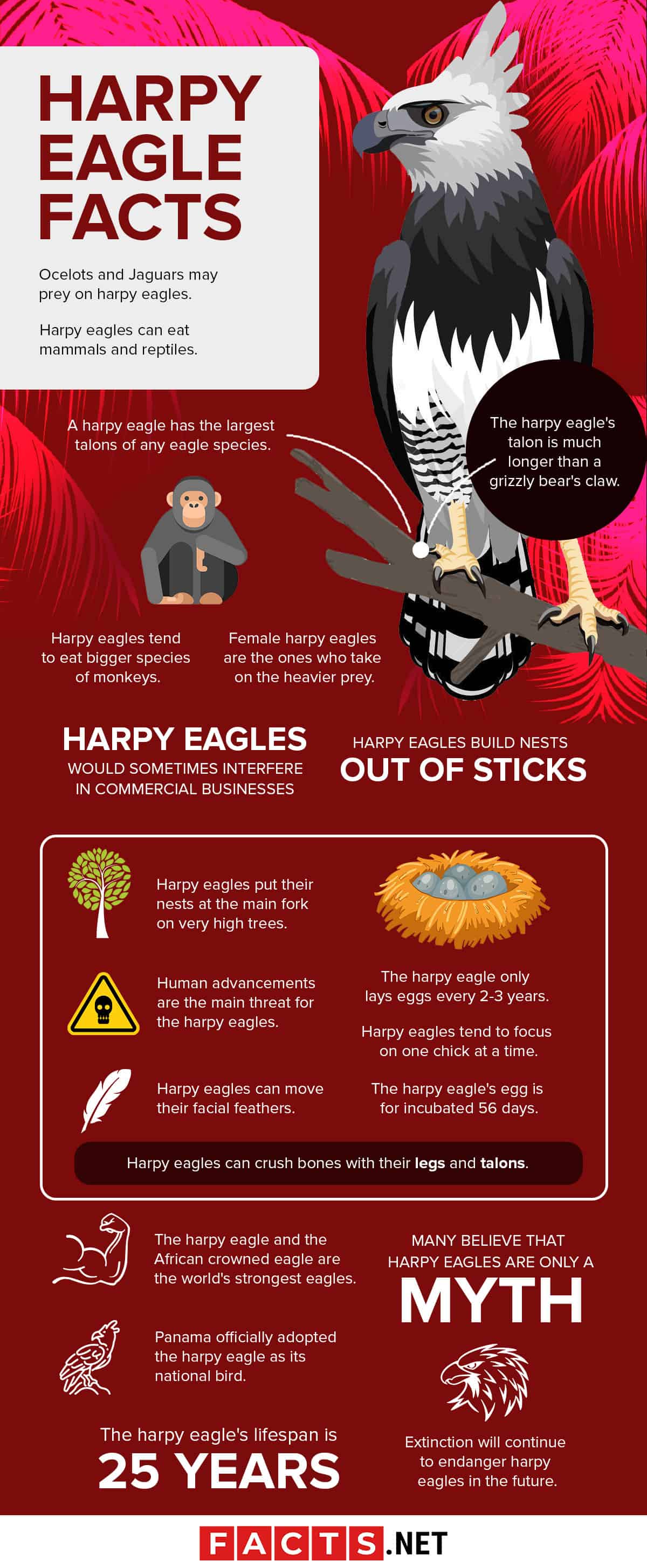
Harpy eagles are the second-largest species of rainforest-dwelling raptors. They are strong predators above other animals in their habitat. However, what else is there to know about these birds? See for yourself with these harpy eagle facts.
- The harpy eagle is a neotropical species of eagle.
- They are the rainforest’s largest and most powerful raptor.
- Harpy eagles are one of the largest eagle species in the world as well.
- They can grow more than 1 meter long and have a wingspan of 7.5 feet.
- American harpy eagle and Papuan eagle are the other names of a harpy eagle.
- Although harpy eagles are big, the Steller’s Sea Eagle is the biggest eagle species. The Steller’s Sea Eagle can weigh as much as 9 kilograms and can reach a wingspan of more than 7 feet.
- The average weight of the harpy eagle Is around 4 to 5 kilograms.
- Harpy eagles prefer to stay in the tropical lowland rainforests.
- Unfortunately, disruptions of their natural habitat have caused them to go down in numbers.
- Carl Linnaeus, a Swedish botanist and zoologist, first described the harpy eagle in 1758 as “Vultur Harpyja.”
- The harpy eagle is closely related to the crested eagle.
- The word ‘harpy’ came from the Ancient Greek word ‘hárpuia,’ which refers to a half-human & half-bird.
- They are on top of the food chain and rarely victimized.
- Harpy eagles are not endangered but threatened or getting close to it.
- In some places such as Mexico and Central America, harpy eagles are close to extinction.
- Brazil is one of the countries with most harpy eagles and can be spotted across the entire country.
- The harpy eagle is known as the ‘royal-hawk’ in Brazil.
- The harpy eagle was previously thought to be closely related to the Philippine eagle.
- Their exact population is unknown. However, the estimated individuals of harpy eagles are still more than 20,000.
- High-grade forestry is the harpy eagle’s best home.
Harpy Eagle Facts Infographics

Ocelots and Jaguars may prey on harpy eagles.
Although harpy eagles are apex predators in terms of ecology, there are uncommon cases where they are attacked and devoured by ocelots and jaguars.
Harpy eagles can eat mammals and reptiles.
As the top predators in their food chain, the harpy eagles’ mainly feed on sloths, opossums, and monkeys. Similarly, they would also prey on other available food sources like macaws and iguanas.
Harpy eagles tend to eat bigger species of monkeys.
Harpy eagles often prey on bigger species of monkeys such as the saki monkeys, squirrel monkeys, spider monkeys, capuchin monkeys, howler monkeys, and titi monkeys. Interestingly, they would ignore smaller species of monkeys like marmosets and tamarins.
A harpy eagle has the largest talons of any eagle species.
Harpy eagles have the largest talons or claws of any living eagle. With these sharp talons, they can lift prey weighing more than or equal to their body weight.
Female harpy eagles are the ones who take on the heavier prey.
Female harpies can take on prey weighing more than 6 lbs, while the males would not engae prey over 5 lbs. An adult female harpy eagle in her prime can grab their targets weighing up to 20 lbs in flight and carry it without landing.
Harpy eagles would sometimes interfere in commercial businesses.
On rare occasions, harpy eagles would take and “steal” livestock such as chicken, lamb, goats, and even piglets.
Harpy eagles build nests out of sticks.
Usually, female harpies will lay one or two white eggs in a large stick nest. They build durable nests that measure 1.2 meters deep and 1.5 meters across and it would already last for several years.
Harpy eagles put their nests at the main fork on very high trees.

Harpy eagles build their nests on high trees in the main fork for more stability. They love to put their nests on kapok trees since it’s one of the tallest trees and start the construction where at least its 16 to 40 meters high.
The harpy eagle only lays eggs every 2-3 years.
Although they don’t lay very frequently, they aggressively defend their eggs and young. Both male and female harpy eagles are capable of incubating their eggs.
Harpy eagles tend to focus on one chick at a time.
The harpy eagle couple habitually raises only one chick every 2 to 3 years. As a result, after the first chick hatches, the second egg could be neglected and frequently fails to hatch except if the first egg dies.
The harpy eagle's egg is for incubated 56 days.
A harpy eagle’s egg is incubated for around 56 days. When the eaglet reaches 36 days old, it starts walking. The harpy eaglet develops its feathers at the same time it develops flight at 6 months old. However, its parents will continue to provide food for the young for the next 6 to 10 months.
Human advancements are the main threat for the harpy eagles.
The main threats for harpy eagles are extensive logging, cattle ranching, and agricultural advancement. These factors all endanger their food and shelter.
Harpy eagles can move their facial feathers.
Similar to an owl, the harpy eagle’s facial disk feathers can be lowered or lifted if they wanted to. This process helps them direct sound waves to their ears and improve hearing.

The harpy eagle's talon is much longer than a grizzly bear's claw.
A full-grown harpy eagle’s talon measures 5 inches long – which is much longer than a grizzly bear’s claw growing 2 to 4 inches only.
Harpy eagles can crush bones with their legs and talons.
The harpy eagle’s legs and talons can apply over 110 pounds of pressure, immediately crushing the bones of its target.
The harpy eagle and the African crowned eagle are the world's strongest eagles.
The world’s strongest eagle is a subject for debate. When it comes to strength, harpy eagles and the African crowned eagles claim the title of the world’s strongest.
Panama officially adopted the harpy eagle as its national bird.
Panama officially adopted the harpy eagle as its national bird by Law 8 of 2002. Aside from being the national bird of the country, the coat of arms for Panama features it as well as a symbol of the country’s sovereignty.
The harpy eagle's lifespan is 25 years.
All eagles usually live in the wild for around 20-30 years. Compared to most birds, the eagle’s lifespan is much longer. If the eagles are in captivity, along with proper veterinary care and nutrition, their lifespan can be extended to 70 years.
Many believe that harpy eagles are only a myth.
A long time ago, many believed harpy eagles were only mythological creatures. By then, only a few harpies had been spotted in the wild since they only roam near their nests. Rumors spread that they didn’t truly exist since very few people had seen them.
Extinction will continue to endanger harpy eagles in the future.
Although harpy eagles are not endangered species, they are in the list of near-threatened species. In other words, they are in danger of extinction.
Harpy eagles are opportunistic feeders.
The monkeys, sloths, other small reptiles could be the harpy eagle’s favorite meal, but they can also eat snakes and other smaller species of birds if necessary.
Harpy eagles don't "hunt," they wait.
In contrast to other eagle species and animals, harpy eagles don’t wander and stalk its prey. It sits on its territory and waits patiently until the preys come along.

Harpy eagles have sharp eyesight.
In fact, its eyesight is up to 8 times better than humans. When they do lock their sight on a potential meal, they cruise below the forest canopy and swoop in to catch their prey.
Harpy eagles can fly over 80 kilometers per hour.
Harpies could the world’s strongest eagles, but they are not the fastest. The fastest birds are the Peregrine falcon which flies up to 390 kilometers per hour. Furthermore, the golden eagle is the second fastest with the speed of 200 kilometers per hour.
Female harpies need at least 4 years to lay eggs.
The female harpy eagle takes a little while to develop into a fully-grown adult. It only reaches sexual maturity between 4 to 5 years old.
Harpy eagles know "family planning."
Aside from the fact that harpy eagles are monogamous, they don’t mate until their offspring is independent. As a result, they can only lay eggs every two or three years.
Some harpy eagles carry West Nile Virus.
Although some harpy eagles and other species of birds such as owls and hummingbirds tested positive for West Nile Virus, it is very unlikely that a human can get a disease from them. Harpies can also get the West Nile Virus from mosquitoes, other infected birds, or contaminated water.
Harpy eagles don't migrate.
Similar to its hunting strategy, harpies stay in one place and establish their territory instead of migrating. This is why deforestation is the harpy eagle’s archenemy.
The population of the harpy eagle is correlated in the overall ecosystem.
According to scientists, a healthy population of harpy eagles represents a good ecosystem. Since they are at the top of the food chain, the increase of their numbers will show and prove that the lower food chain is also healthy.
The female harpy eagles are much bigger than the males.
From a distance, it’s almost impossible to tell if the harpy eagle is a male or a female because they have an identical appearance aside from their size.
Was this page helpful?
Our commitment to delivering trustworthy and engaging content is at the heart of what we do. Each fact on our site is contributed by real users like you, bringing a wealth of diverse insights and information. To ensure the highest standards of accuracy and reliability, our dedicated editors meticulously review each submission. This process guarantees that the facts we share are not only fascinating but also credible. Trust in our commitment to quality and authenticity as you explore and learn with us.


